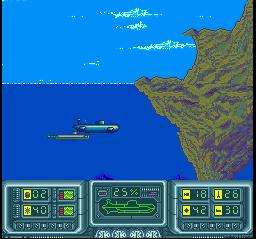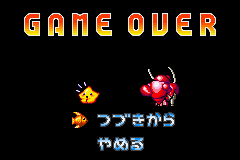In the Hunt
( Otherwise known as "a game so obscure and nondescript, even I haven't heard of it.") Not even Giant Bomb's tag search engine can find it, which explains why I couldn't directly tag this blog to the game. In fact, I don't even remember much about the game, so don't have any high expectations for this half of the blog. Back to the matter at hand, In the Hunt is a side scrolling shmup where you take the role of a submarine. If you, like me, were thinking this would make for a subtle, Hunt For Red October-esque game, prepare for disappointment: it's just an ordinary shmup.Not that there's anything inherently wrong with that part. Like any shmup, you move from left to right, collecting power-ups and blowing up that which has yet to be blown up. The bad part comes in when you realize how easy it is to do all this. The power-ups you collect are ridiculously powerful, and the screen doesn't automatically scroll. You control when the screen progresses, beat em up style, meaning you can shoot up nearby enemies at your own pace, move forward, and then repeat ad infinitum. "But wait," you're telling me, "there must be a time limit, right?" Yes, there is a time limit, but it's a limit in the same sense that Cartoon Network airs cartoons, by which I mean that it isn't much of a limit. It counts down at an incredibly slow pace, and like Final Fight 3, the only time when I was in danger of running out of time was at the end, where death resets the clock.

However, I think I can see why Irem was able to be so creative: I just named almost all the levels in the game. Yes, there are only five levels to be found.....in the hunt. And once you've beaten those five levels, there's no reason to go back. No alternate submarines to play as, no branching paths, not even for the challenge! Just play it once, beat it, and move onto another game, like I did. However, I did not forget it long enough to forget the award. The award, you ask? The Guardian Legend Award for Especially Poor Irem Shooters.
Review Synopsis
- Easier than writing an episode of Beavis and Butthead.
- Shorter than the life of a television show everybody knows is good, but for some reason, gets canceled to make way for crap. You know what I'm talking about.
- About as notable as....actually, I don't have much of an analogy for this one. It's not really notable.
Displayed for your attention is the result of douchebags owning an advertising agency:
Densetsu no Stafy
( When was the last I played a GBA game?) I believe it was Mother 3, a game which I recall not being very good. But that should come as no surprise to anyone familiar with my hatred of Earthbound; what should come as a little bit of a surprise is that I enjoyed this game, despite the latest game not getting a good score here. On the beginning of my quest to beat a crapload of GBA games, things are starting on a decent note.However, that's not how the story of this game started. Here's how it works: there's this starfish named Stafy, and he's the prince of a sky kingdom, for some reason. One day, he's carrying things with his stubby little "hands", and the inevitable happens: he drops it all. Turns out one of those things was a jar holding a dark and evil villain who has now been released from his jarry tomb. Understandably, everybody realizes how much of a massive idiot Stafy is and kick him out. Now Stafy must return to his kingdom and destroy the evil he released, his only help being an old lobster man and an annoying clam. I feel like I'm repeating myself when I say I can't read Japanese, but I also feel somewhat weird in saying that I still found the bastard annoying. He only pops up to tell me what I've already figured out, or to block my passage for some arbitrary reason.
So I had to find an alternate path or find something that would somehow allow me to progress. In that respect, the levels are somewhat non-linear, but given their small size, it's fairly easy to navigate them. Kind of like Kirby. In fact, if I could sumarize Densetsu no Stafy in one phrase, that would be "the unrecognized bastard child of Kirby and Ariel." Both Kirby and Stafy are cutesy portable platformers based around simple concepts. The only major difference I found is that Stafy doesn't suck up enemies and cannibalize their powers; instead, he spins around like an idiot, somehow killing things with his stubby little hands. If you consider that surprising, then you'll crap your pants when you realize that the game pulls this spinning thing off surprisingly well. There are puzzles that involve use of the spinning feature, platforms that can only be reached by spin-jumping out of the water, and a few areas that kinda require you to spin as fast you can to the exit.

Wait, that last sentence reminded me of something: there are actually out of water portions to this game. Densetsu no Stafy is a water themed game (hence the title), but there are portions when Stafy must jump from the water onto land in order to progress. However, Super Mario Sunshine, these portions of the game don't make me want to watch the credits of the game so I know who to murder. In fact, these moments actually feel like natural moments of the game. You can attack enemies, run, jump, and do all the other things that are standard fare in platformers. So what makes these portions of the game so special? Well, maybe the fact that they exist. I've spent a lot of time complaining about how water themes in video games seem to limit them from a gameplay perspective, but this is definitely a game that proves water does not have to be limiting.
In fact, the problem may be that the game isn't limiting enough. I never really died, and even when I came close, there are enough health refills to heal 9 Stafys (Stafi? Stafis? Stafy? What's the plural, here?). The bosses, while creative, are also very easy; once you find out how to damage them, you've pretty much won. I'd also criticize it for being simple, but I actually found that to be a good thing for this game; with portable games, you don't want to spend half your time figuring out how to play the game, you just want to play the game under the table when nobody is paying attention. Stafy does this well, and because of that, is a great portable game. However, that greatness is compromised by a few dark levels. This may not sound like much until you remember the early GBAs. Remember? Remember how they had no backlight, and you had to use that GBA port light and complex geometric equations so you could actually see the screen and not your ugly reflection? Add in the fact that Nintendo made this game and the system it was on, and you can see why this game only got a 7.0 out of 10. And the Patrick Star Award for Simplistic Stupidity.
Review Synopsis
- It meshes the water and non-water portions very nicely.
- A bit on the easy side.
- Fortunately, this game is of the simple "pick up and play" nature.
Log in to comment